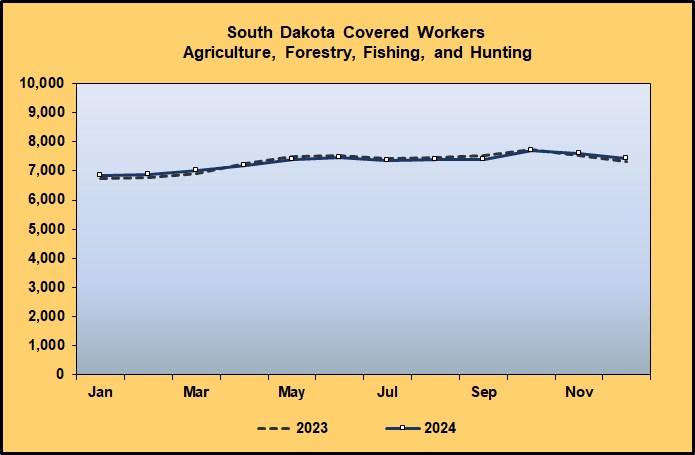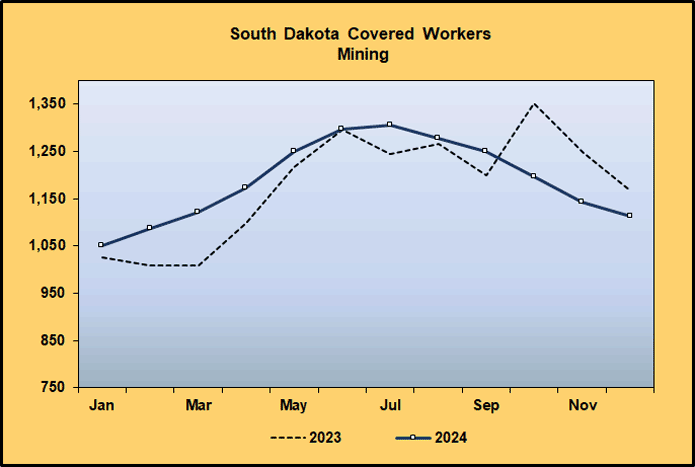- Home to LMIC
- Virtual Labor Market Data System
- Career Exploration & Planning
- Consumer Price Index
- Demographics
- Economic Snapshot
- Employee Benefits
- Employment Projections
- Labor Force & Unemployment
- Labor Supply
- Overview of the Current Labor Market
- Surveys We Conduct
- Wages & Income
- Workers by Industry
- Tools & Resources
- Publications
- References
- What's New
- Can't Find It?
Labor Market Information Center
2024 Annual Report
Quarterly Census of Employment and Wages
Natural Resources & Mining Supersector
The Natural Resources and Mining supersector is comprised of the Agriculture, Forestry, Fishing and Hunting sector and the Mining, Quarrying, and Oil and Gas Extraction sector. Examples of business activities in this supersector group include growing crops, raising livestock, managing farm services, logging, and extracting natural mineral solids at a mine site.
| South Dakota Covered Workers and Pay 2024 |
|||
| Supersector, Sector and Subsector | Number of Establishments | Average Number of Workers | Annual Pay |
| Natural Resources and Mining | 1,369 | 8,491 | $57,089 |
| Agriculture, Forestry, Fishing, and Hunting | 1,279 | 7,302 | $51,329 |
| Crop Production | 583 | 2,183 | $47,513 |
| Animal Production and Aquaculture | 495 | 4,269 | $50,982 |
| Forestry and Logging | 20 | 85 | $50,667 |
| Fishing, Hunting, and Trapping | 6 | 7 | $69,232 |
| Support Activities for Agriculture and Forestry | 175 | 759 | $64,098 |
| Mining, Quarrying and Oil and Gas Extraction | 90 | 1,189 | $92,464 |
| Oil and Gas Extraction | 2 | 23 | $123,431 |
| Mining, except Oil and Gas | 56 | 941 | $82,695 |
| Support Activities for Mining | 32 | 225 | $130,154 |
| Totals may not add due to rounding. Data subject to revision. Produced by the Labor Market Information Center, South Dakota Department of Labor and Regulation, in cooperation with the U.S. Bureau of Labor Statistics. |
|||
Agriculture, Forestry, Fishing and Hunting
NAICS Sector 11
The Agriculture, Forestry, Fishing and Hunting sector remained relatively stable in 2024, with a loss of one worker since 2023 (0.0%) resulting in an annual average employment level of 7,302. The annual pay for 2024 was $51,329, an increase of $2,451 or 5.0% compared to 2023.
Most individuals employed in Agriculture, Forestry, Fishing and Hunting are considered 'non-covered' (meaning they are not covered by unemployment insurance) and are therefore not included in the Quarterly Census of Employment and Wages (QCEW) program. If the non-covered workers were included, this sector would be one of the largest industries in South Dakota in terms of employment.
According to the U.S. Bureau of Labor Statistics (BLS), the QCEW monthly employment data represents the number of covered workers who worked during or were paid for the pay period including the 12th day of the month. The program excludes proprietors, the unincorporated self-employed, unpaid family members, certain farm and domestic workers, and railroad workers covered by the railroad unemployment insurance system.
Between 2023 and 2024, three subsectors under the Agriculture, Forestry, Fishing and Hunting sector reported gains, while two decreased in workers.
- Crop Production increased by 23 workers (1.1%)
- Animal Production and Aquaculture increased by 61 workers (1.4%)
- Forestry and Logging decreased by five workers (5.6%)
- Fishing, Hunting and Trapping increased by four workers (133.3%)
- Support Activities for Agriculture and Forestry decreased by 82 workers (9.8%)
Some percentage changes are misleading due to low employment numbers. For example, the Fishing, Hunting and Trapping subsector has only seven workers as of 2024, so a small increase leads to a large percent change. The actual number of workers by subsector, from largest to smallest, are:
- Animal Production and Aquaculture (4,269)
- Crop Production (2,183)
- Support Activities for Agriculture and Forestry (759)
- Forestry and Logging (85)
- Fishing, Hunting, and Trapping (seven)
While employment numbers remained stable, the sector saw a gain of 39 establishments, growing from 1,240 in 2023 to 1,279 in 2024.
All subsectors showed annual wage increases except for Forestry and Logging, which experienced a slight decline. Fishing, Hunting, and Trapping had the largest wage increase at $32,751 (89.8%). Support Activities for Agriculture and Forestry increased $8,417 (15.1%), Animal Production rose $1,957 (4.0%), and Crop Production increased $1,648 (3.6%). Forestry and Logging wages declined by 2.0%.
Overall, employment in the Agriculture, Forestry, Fishing and Hunting remained solid in 2024 with a minor decline, mainly due to decreases in the Support Activities for Crop Production industry group. Positive gains were seen in Oilseed and Grain Farming, Hog and Pig Farming, Poultry and Egg Production, and Support Activities for Animal Production. Advances in technology and improved farming efficiency continue to reduce the need for field workers, particularly in the Support Activities for Crop Production industry group.

Mining, Quarrying, and Oil and Gas Extraction
NAICS Sector 21
The Mining, Quarrying, and Oil and Gas Extraction sector gained 11 workers (0.9%) between 2023 and 2024, bringing employment to 1,189. At the subsector level, one gained workers while two lost workers. Average annual pay for the sector decreased by $2,518 (2.7%) to $92,464 in 2024. This sector ranked third among the higher-paying industries.
According to the U.S. Geological Survey (USGS), South Dakota has 1,128 records of mines listed. The top five counties by number of mines in South Dakota are:
- Custer 381
- Lawrence 353
- Pennington 155
- Meade 97
- Harding 88
The Oil and Gas Extraction (NAICS 211) subsector maintained their two establishments from 2023 to 2024, but employment decreased by two workers (8.0%). This subsector includes establishments that operate and develop oil and gas field properties and recover liquid hydrocarbons from oil and gas field gasses. Annual pay rose slightly by $95 (0.1%). Given the subsector’s relatively small size and the temporary nature of many jobs, minor changes have a significant percentage impact.
The Mining (Except Oil & Gas) subsector (NAICS 212) added 39 workers (4.3%) and three establishments. Activities include mining, developing mine sites, and preparing metallic and nonmetallic minerals, including coal. The average annual pay increased by $3,065 (3.8%) to $82,695 in 2024.
The Support Activities for Mining (NAICS 213) subsector lost 27 workers or 10.7%, reducing total employment to 225 workers. This subsector provides contract or fee-based support services required for mining, quarrying, and oil and gas extraction, including exploration activities like prospecting and core sampling. Annual pay decreased by $16,591 or 11.3%. This subsector is highly volatile and can experience significant seasonal fluctuations. It gained four establishments in 2024.
Nationally, South Dakota ranked 37th among all states in the value of nonfuel mineral commodities produced in 2024 at $389 million. The state’s principal nonfuel mineral commodities include cement, gold, lime, sand, gravel, and stone. The demand for workers within the Mining, Quarrying, and Oil and Gas Extraction sector correlates with the production needs of these minerals and is connected to the demands of the Construction sector.

